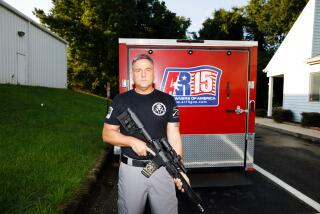Military Weaponry in Civilian Hands
- Share via
WASHINGTON — When Army researchers studied battlefield casualties after the Korean War, they turned up a major surprise. A carefully aimed rifle, they learned, did less damage to the enemy than did shooting at random.
Today, half a century later, the results of that study are playing a role in the chilling sniper attacks in and around the nation’s capital. The Army went on to develop a more accurate rifle for use at moderate ranges. And someone is now using a version of it to kill civilians.
Authorities have not said whether they know which make of firearm the sniper is using. But they have revealed that many of the victims were hit by a single .223-caliber round. As many as 28 types of weapons are thought to handle a slug that size.
Originally, the .223 was developed to solve the problems outlined by the Army researchers. “Once that round was adopted by the military, it was also quickly adopted for civilian use,” said Tom Diaz of the Violence Policy Center, a Washington group working to reduce firearm violence. “I would say it’s now ubiquitous.”
“I don’t believe it’s that good for hunting,” said Joe Vince, a former head of the crime guns analysis unit of the federal Bureau of Alcohol, Tobacco and Firearms. “I think there’s a lot better deer-hunting rifles out there.”
In their statistical study of battlefield wounds, the Army researchers considered 3 million casualty reports from World War I, World War II and Korea. They concluded that long-range shooting was seldom effective and that even top marksmen could not hit targets beyond 300 yards, according to Duncan Long in his book “The Complete AR-15/M16 Sourcebook.”
The study signaled that the Army should scrap the heavier ammunition designed to travel long distances. It showed the need for lighter bullets traveling at higher velocity, capable of use over shorter distances and of piercing body armor.
The Army challenged gun makers to produce a lightweight weapon to handle that kind of ammunition. By the early 1960s, the ArmaLite AR-15 became the leading contender.
Made by the ArmaLite division of Fairchild Industries, an airplane and engine company, the AR-15 eventually sold well in foreign nations, notably in South Vietnam. It also was the prototype for the U.S. military’s official rifle, the M-16, a fixture of the Vietnam War that eventually was adopted by NATO and other military institutions.
At the same time, the .223 entered civilian use. Because the ammunition was widely available, gun makers created a range of weapons to use it. “And firearms that have some military or police cachet just sell better,” Diaz said. “Some people just like that kind of branding, so to speak.”
Weapons that fire .223-caliber rounds include the Sturm, Ruger Mini-14 and the Colt AR-15, a descendant of the original AR-15. The Colt weapon is the civilian, semiautomatic version of the fully automatic M-16. Colt bought the rights to the AR-15 even before it became a popular military weapon.
The Colt AR-15 is banned as part of the 1994 federal assault weapon ban, though weapons lawfully owned before the ban may still be possessed and sold. The Ruger model was exempted from the 1994 ban.
Vince said the .223 would make a good target-shooting round but is less useful for hunting. Taking down a deer, which has a larger frame than a person, would generally require a larger round, he said.
Former FBI senior metallurgist William A. Tobin said the bullet can be devastating to a person.
Tobin, who carried an M-16 as a Marine in Vietnam, said the light weight of the round means it can travel with high speed, imparting high energy against its target. In addition, the bullet tends to wobble, causing great internal injures.
“It just does incredible damage,” he said.
More to Read
Sign up for Essential California
The most important California stories and recommendations in your inbox every morning.
You may occasionally receive promotional content from the Los Angeles Times.










